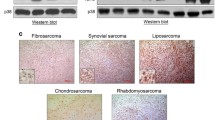Abstract
Gα12, the α-subunit of G protein G12, is ubiquitously expressed and it has been identified as a putative “causative oncogene” of soft-tissue sarcomas. Overexpression of wild-type or GTPase-deficient mutant of Gα12 (Gα12Q229L or Gα12QL) leads to the oncogenic transformation of NIH3T3 cells. Gα12QL-tramsformed NIH3T3 cells show a distinct oncogenic phenotype defined by increased cell proliferation, anchorage-independent growth, reduced growth-factor dependency, attenuation of apoptotic signals, and neoplastic cytoskeletal changes. In this study, the genes contributing to the reduced growth-factor dependency of Gα12QL-NIH3T3 cells were identified by transcription profiling of serum-starved Gα12QL-transformed NIH3T3 (Gα12QL-NIH3T3) cells. Results from these studies indicate that Gα12QL stimulates the expression of genes that promote cell growth. The increased expressions of growth-promoting genes in Gα12QL-NIH3T3 cells were validated by semiquantitative reverse transcription-polymerase chain reaction and immunoblot analyses. Further studies aimed at investigating the critical role of two of such upregulated genes, namely PDGFRα and JAK3, indicated that the inhibition of PDGFRα or JAK3 activity-attenuated Gα12QL-mediated serum-independent cell proliferation. These studies point to possible novel autocrine and/or paracrine control mechanisms involving PDGFRα and JAK3 in Gα12-mediated proliferation and oncogenesis.
Similar content being viewed by others
References
Johnson, G. L. and Dhanasekaran, N. (1989) The G-protein family and their interaction with receptors. Endocr. Rev. 3, 317–331.
Dhanasekaran, N. and dermott, J. M. (1996) Signaling by the G12 class of G proteins. Cell Signal. 8, 235–245.
Chan, A. M., Fleming, T. P., McGovern, E. S., Chedid, M., Miki, T., and Aaronson, S. A. (1993) Expression cDNA cloning of a transforming gene encoding the wild-type Gα12 gene product. Mol. Cell. Biol. 2, 762–768.
Jiang, H., Wu, D., and Simon, M. I. (1993) The transforming activity of activated Gα12. FEBS Lett. 330, 319–322.
Xu, N., Bradley, L., Ambudkar, I., and Gutkind, J. S. (1993) A mutant α subunit of G12 potentiates the eicosanoid pathway and is highly oncogenic in NIH3T3 cells. Proc. Natl. Acad. Sci. USA 90, 6741–6745.
Voyno-Yasenetskaya, T. A., Pace, A. M., and bourne, H. R. (1994) Mutant α subunits of G12 and G13 proteins induce neoplastic transformation of Rat-1 fibroblasts. Oncogene 9, 2559–2565.
Mao, J., Xie, W., Yuan, H., Simon, M. I., Mano, H., and Wu, D. (1998) Tec/Bmx non-receptor tyrosine kinases are involved in regulation of Rho and serum response factor by Gα12/13. EMBO J. 17, 5638–5646.
Meigs, T. E., Fields, T. A., McKee, D. D., and Casey, P. J. (2001) Interaction of Gα12 and Gα13 with the cytoplasmic domain of cadherin provides a mechanism for β-catenin release. Proc. Natl. Acad. Sci. USA 98, 519–524.
Vara Prasad, M. V. V. S., Dermott, J. M., Heasley, L. E., Johnson, G. L., and Dhanasekaran, N. (1995) Activation of Jun kinase/stress-activated protein kinase by GTPase-deficient mutants of Gα12 and Gα13. J. Biol. Chem. 270, 18,655–18,659.
Vara Prasad, M. V. V. S., Shore, S. K., and Dhanasekaran, N. (1994) Activated mutant of Gα13 induces Egr-1, c-fos, and transformation in NIH3T3 cells. Oncogene 8, 2425–2429.
Hunter, T. (2000) Signaling—2000 and beyond. Cell 100, 113–127.
O'Shea, J. J., Gadina, M., and Schreiber, R. D. (2002) Cytokine signaling in 2002: new surprises in Jak/Stat pathway. Cell 109, S121-S131.
Heldin, C. H., Ostman, A., and Ronnstrand, L. (1998) Signal transduction via platelet-derived growth factor receptors. Biochim. Biophys. Acta 1378, F79-F113.
Levitzki, A. and Gazit, A. (1995) Tyrosine kinase inhibition: an approach to drug development. Science 267, 1782–1787.
Nebigil, C. G., Launay, J-M., Hickel, P., Tournois, C., and Maroteaux, L. (2000) 5-Hydroxytryptamine 2B receptor regulates cell-cycle progression: cross-talk with tyrosine kinase pathways. Proc. Natl. Acad. Sci. USA 97, 2591–2596.
Zwerner, J. P. and May, W. A. (2002) dominant negative PDGF-C inhibits growth of Ewing family tumor cell lines. Oncogene 21, 3847–3854.
Goodman, P. A., Niehoff, L. B., and Uckun, F. M. (1998) Role of tyrosine kinases in induction of the c-jun proto-oncogene in irradiated B-lineage lymphoid cells. J. Biol. Chem. 273, 17,742–17,748.
Song, B. and Wang, C. (1996) Cell-type-specific platelet-derived growth factor α receptor: a role for GATA binding protein. Mol. Cell. Biol. 16, 712–723.
Fukuoka, T., Kitami, Y., Okura, T., and Hiwada, K. (1999) Transcriptional regulation of the platelet-derived growth factor α receptor gene via CCAAT/enhancer-binding protein-δ in vascular smooth muscle cells. J. Biol. Chem. 274, 25,576–25,582.
Afink, G. B., Nister, M., Stassen, B. H., et al. (1995) Molecular cloning and functional characterization of the human platelet-derived growth factor α receptor gene promoter. Oncogene 10, 1667–1672.
Shen, Y., Devgan, G., Darnell, J. E., Jr., and Bromberg, J. F. (2001) Constitutively activated Stat3 protects fibroblasts from serum with-drawal and UV-induced apoptosis and antagonizes the proapoptotic effects of activated Stat1. Proc. Natl. Acad. Sci. USA 98, 1543–1548.
Bromberg, J. F., Horvath, C. M., Besser, D., Lathem, W. W., and Darnell, J. E., Jr. (1998) Stat3 activation is required for cellular transformation by v-src. Mol. Cell. Biol. 18, 2553–2558.
Bowman, T., Garcia, R., Turkson, J., and Jove, R. (2000) STATs in oncogenesis. Oncogene 19, 2474–2488.
Herrlich, A., Daub, H., Knebel, A., et al. (1998) Ligand-independent activation of platelet-derived growth factor receptor is a necessary intermediate in lysophosphatidic acid-stimulated mitogenic activity in L cells. Proc. Natl. Acad. Sci. USA 95, 8985–8990.
Author information
Authors and Affiliations
Corresponding author
Rights and permissions
About this article
Cite this article
Kumar, R.N., Radhika, V., Audigé, V. et al. Proliferation-specific genes activated by Gα12 . Cell Biochem Biophys 41, 63–73 (2004). https://doi.org/10.1385/CBB:41:1:063
Issue Date:
DOI: https://doi.org/10.1385/CBB:41:1:063




